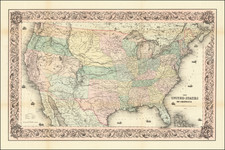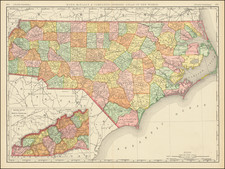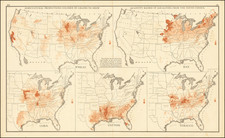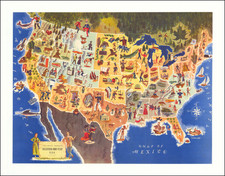Scarce map of the United States, showing the state of "Frankland" in western North Carolina, predating the appearance of Tennessee.
Georgia , the Carolinas and Virginia extend to the Mississippi (although Kentucke is named).
A large area in the old Northwest is identified as land ceded to the United States. Many western Forts are shown, especially west of the Mississippi and North of the Missouri River. Kansez is named. The vast prairies of Buffalo People are shown. Tecas is named. Indiana and Ohio are named, but badly misconfigured.
A terrific map, which appeared in volume 116 of the Histoire Universel and is listed in Ashley Baynton Williams work on Franklina, the third earliest appearance of the name. (Map Collector 72:15, #3)
State of Franklin
The map is one of the few maps to record the short-lived state of "Franklinia" or "Frankland".
In the latter part of the 18th Century, the settlers in Western North Carolina and Eastern Tennessee decided that because of poor representation in State Government, they needed to form a state of their own. A government was formed and initial organizational meetings conducted, but the breakaway state was quickly quelled by the North Carolina authorities, although not before the State of Franklinia began appearing on a number of English maps during the period.
Louis Brion de la Tour (ca. 1743-1803) was a French geographer and demographer. Little is known about Louis’ early life, but some glimpses of his professional life survive. He did achieve the title of Ingénieur Géographe du Roi. Much of his work was done in partnership with Louis Charles Desnos, who was bookseller and geographical engineer for globes to the Danish Crown. He worked on the Indicateur fidèle ou guide des voyageurs, qui enseigne toutes les routes royales between 1762 and 1785. During his career he also worked on several atlases. By 1795, he had gained a pension from the National Assembly. Perhaps this pension was granted in part because his son, also Louis Brion de la Tour (1763-1823), was an engraver who made Revolutionary prints, as well as maps.









![The Theatre of War in North America, with the Roads, and Tables, of the Superficial Contents, Distances, &c.a By and American [with] A Compendious Account of the British Colonies in North-America.](https://storage.googleapis.com/raremaps/img/small/81762.jpg)




![(French & Indian War) The New Map of the British Dominions in North America; with the Limits of the Government annexed thereto by the late Treaty of Peace, and settled by Proclamation October 7th, 1763 [in:] The Annual Register, or a View of the History, Politicks, and Literature, for the Year 1763. Volume 6](https://storage.googleapis.com/raremaps/img/small/77573.jpg)